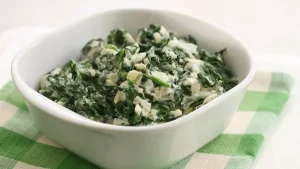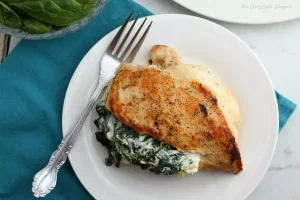Spinach, a leafy green vegetable known for its vibrant color and nutrient-rich profile, has been a staple in cuisines across the globe for centuries. Whether enjoyed as a side dish, incorporated into salads, or used as a key ingredient in various recipes, spinach offers a plethora of health benefits and a versatile flavor profile. In this comprehensive guide, we will delve into the art of cooking spinach, exploring its nutritional value, different cooking methods, and a selection of delectable recipes that showcase the remarkable potential of this humble leafy green.
Nutritional Facts of Spinach
Before we embark on our culinary journey, let’s take a moment to appreciate the nutritional value that spinach brings to our plates. Spinach is a powerhouse of essential vitamins, minerals, and antioxidants that contribute to overall well-being. Rich in vitamins A, C, and K, as well as folate and iron, spinach supports immune function, bone health, and helps prevent anemia. Additionally, its high fiber content aids digestion and promotes a healthy gut.
See Also: 17 Reasons Why Spinach Is Called A Superfood
Selecting the Freshest Spinach
Cooking with spinach starts with selecting the freshest leaves. When purchasing spinach, look for vibrant, dark green leaves that are free from wilting or yellowing. Opt for organic options whenever possible, as they are less likely to be treated with pesticides and chemicals. If buying pre-packaged spinach, ensure that the leaves are not slimy or damp, as this indicates spoilage.
Preparing Spinach for Cooking
Properly preparing spinach is a crucial step to ensure that your dishes turn out delicious and visually appealing. Follow these steps to clean and prepare your spinach:
1. Washing: Place the spinach leaves in a colander and rinse them thoroughly under cold running water. Gently swish the leaves around to remove any dirt or debris. You may need to repeat this process a few times until the water runs clear.
2. Drying: After washing, gently pat the leaves dry with a clean kitchen towel or use a salad spinner to remove excess moisture. Drying the leaves helps prevent sogginess when cooking.
3. Trimming: If your spinach bunch includes stems that are tough or fibrous, trim them away using a sharp knife. Focus on retaining the tender leaves for cooking.
Cooking Methods of Spinach
The versatility of spinach is evident in the variety of cooking methods that can be employed to bring out its flavors and textures. Each method offers a unique culinary experience:
1. Steaming
Steaming spinach is a gentle cooking method that preserves its vibrant color and nutritional content. Follow these steps for perfectly steamed spinach:
Bring a pot of water to a boil and place a steamer basket or colander over it.
Add the prepared spinach leaves to the steamer basket and cover with a lid.
Steam for 2-3 minutes until the leaves are wilted and tender.
Remove the spinach from the steamer and immediately transfer it to a bowl of ice water to preserve its color.
Once cooled, gently squeeze out excess water from the spinach before using it in your desired recipe.
2. Sautéing
Sautéed spinach offers a delightful combination of flavors and textures, with a slight hint of caramelization. To sauté spinach:
Heat a skillet over medium heat and add a small amount of olive oil or butter.
Add minced garlic and sauté for about 1 minute until fragrant.
Add the prepared spinach leaves and toss them in the skillet.
Sauté for 2-3 minutes until the leaves are wilted and have reduced in volume.
Season with salt, pepper, and a dash of lemon juice for added brightness.
3. Blanching
Blanching spinach is a technique that involves briefly boiling the leaves before shocking them in ice water. This method helps maintain the vibrant green color while slightly softening the leaves. Here’s how to blanch spinach:
Bring a pot of water to a rolling boil and add a pinch of salt.
Carefully add the prepared spinach leaves and blanch for 20-30 seconds.
Using a slotted spoon, immediately transfer the blanched spinach to a bowl of ice water.
Once cooled, drain the spinach and gently squeeze out excess water.
4. Raw
Spinach can also be enjoyed raw, either as a base for salads or as an ingredient in green smoothies. The tender leaves offer a refreshing and crisp texture, along with all their natural nutrients.
Is it better to cook spinach or eat it raw?
1. Eating Spinach Raw:
Advantages:
- Nutrient Retention: Eating spinach raw preserves its maximum nutritional content, as cooking can lead to the loss of certain heat-sensitive vitamins like vitamin C and folate.
- Texture and Freshness: Raw spinach has a crisp texture and a fresh, earthy taste that many people enjoy, especially in salads.
- Digestive Enzymes: Raw spinach contains enzymes that aid digestion and promote gut health.
Considerations:
- Oxalic Acid: Raw spinach contains oxalic acid, which can interfere with the absorption of certain minerals, such as calcium and iron. Cooking spinach can help reduce oxalic acid levels.
- Nutrient Bioavailability: While raw spinach contains high levels of nutrients, the body’s ability to absorb some of these nutrients might be limited due to the presence of oxalic acid. Cooking spinach can make certain nutrients more accessible.
2. Cooking Spinach:
Advantages:
- Oxalic Acid Reduction: Cooking spinach can significantly reduce its oxalic acid content, making minerals like calcium and iron more bioavailable.
- Nutrient Preservation: While cooking can lead to the degradation of heat-sensitive vitamins, it can enhance the availability of other nutrients, such as beta-carotene (a precursor to vitamin A) and lutein.
- Easier Digestion: Cooking spinach breaks down its tough cell walls, making it easier for the body to digest and absorb nutrients.
Considerations:
- Nutrient Loss: Some nutrients, such as vitamin C and folate, can be partially lost during cooking, especially when using high heat or prolonged cooking times.
- Texture Changes: Cooking can cause spinach to wilt and lose its crisp texture, which might affect its appeal in dishes like salads.
Delectable Spinach Recipes
Now that we’ve explored various cooking methods, let’s put our knowledge into practice with a selection of appetizing spinach recipes:
1. Creamed Spinach

Ingredients:
- 1 pound fresh spinach, washed and trimmed
- 2 tablespoons butter
- 2 cloves garlic, minced
- 1/2 cup heavy cream
- 1/4 cup grated Parmesan cheese
- Salt and pepper to taste
- Pinch of nutmeg (optional)
Instructions:
1. In a large skillet, melt the butter over medium heat.
2. Add the minced garlic and sauté for about 1 minute until fragrant.
3. Gradually add the fresh spinach, stirring until wilted.
4. Pour in the heavy cream and bring to a gentle simmer.
5. Stir in the grated Parmesan cheese and nutmeg, if using.
6. Cook for an additional 2-3 minutes until the sauce thickens.
7. Season with salt and pepper to taste.
8. Serve the creamed spinach as a delectable side dish.
2. Spinach and Feta Stuffed Chicken Breast

Ingredients:
- 2 boneless, skinless chicken breasts
- 1 cup fresh spinach, cooked and chopped
- 1/2 cup crumbled feta cheese
- 1 teaspoon dried oregano
- Salt and pepper to taste
- Olive oil for cooking
Instructions:
1. Preheat the oven to 375°F (190°C).
2. Butterfly the chicken breasts by slicing horizontally almost all the way through and opening like a book.
3. Season the inside of the chicken breasts with oregano, salt, and pepper.
4. Mix the cooked and chopped spinach with the crumbled feta cheese.
5. Stuff each chicken breast with the spinach and feta mixture, then secure with toothpicks.
6. Heat olive oil in an oven-safe skillet over medium-high heat.
7. Sear the stuffed chicken breasts for 2-3 minutes on each side until golden brown.
8. Transfer the skillet to the preheated oven and bake for about 15-20 minutes, until the chicken is cooked through.
9. Remove the toothpicks before serving.
3. Spinach and Mushroom Quiche

Ingredients:
- 1 prepared pie crust
- 2 cups fresh spinach, cooked and chopped
- 1 cup mushrooms, sliced and sautéed
- 1 cup shredded Gruyère cheese
- 4 large eggs
- 1 cup milk or heavy cream
- Salt, pepper, and nutmeg to taste
Instructions:
1. Preheat the oven to 375°F (190°C).
2. Place the pie crust in a pie dish and crimp the edges.
3. Spread the cooked spinach and sautéed mushrooms evenly over the crust.
4. Sprinkle the shredded Gruyère cheese over the vegetables.
5. In a bowl, whisk together the eggs, milk or heavy cream, salt, pepper, and a pinch of nutmeg.
6. Pour the egg mixture over the vegetables and cheese in the pie crust.
7. Place the quiche in the preheated oven and bake for 30-35 minutes, until the filling is set and the top is golden brown.
8. Allow the quiche to cool slightly before slicing and serving.
FAQs About Cooking Spinach
Q1. How can I prevent spinach from becoming too soggy when cooking?
To prevent spinach from becoming overly soggy, ensure that you dry the leaves thoroughly after washing. Excess moisture can lead to a watery final dish. Additionally, when sautéing or cooking spinach, avoid using too much oil or water. The high water content in spinach can contribute to excess liquid in the pan. Using a high heat setting and cooking spinach for a short duration can help maintain its texture and prevent excessive sogginess.
Q2. Can I freeze spinach for later use?
Yes, you can freeze spinach for later use. However, freezing can cause the leaves to become limp upon thawing, which makes frozen spinach ideal for recipes where texture is less important, such as in soups, stews, smoothies, and cooked dishes. To freeze spinach, blanch it briefly in boiling water, then transfer it to an ice water bath. Once blanched, squeeze out excess moisture, portion it into freezer-safe bags or containers, and store in the freezer for up to 6-8 months.
Q3. Is it necessary to remove spinach stems before cooking?
Spinach stems can be tougher and slightly bitter compared to the leaves. While some spinach varieties have tender stems that can be consumed, it’s generally a good idea to trim away thick or fibrous stems, especially if you’re aiming for a more delicate texture in your dish. Focus on using the tender leaves, as they are typically more desirable for cooking.
Q4. What are some creative ways to use cooked spinach in dishes?
Cooked spinach can be incorporated into a wide range of dishes to add color, flavor, and nutrition. Here are a few creative ideas:
Spinach and Cheese Stuffed Pasta: Use cooked spinach as a flavorful filling for stuffed pasta such as ravioli or tortellini.
Spinach Omelette: Add cooked spinach to your morning omelette for an extra boost of nutrients.
Spinach and Artichoke Dip: Create a creamy dip by combining cooked spinach with artichoke hearts, cream cheese, and seasonings.
Spinach Topping for Pizza: Use cooked spinach as a topping for homemade pizzas along with other favorite ingredients.
Spinach and Quinoa Salad: Mix cooked spinach with cooked quinoa, cherry tomatoes, feta cheese, and a lemon vinaigrette for a refreshing salad.
Q5. Can I use frozen spinach instead of fresh spinach in recipes?
Yes, you can use frozen spinach as a convenient alternative to fresh spinach in many recipes. Frozen spinach is already blanched and chopped, making it easy to incorporate into various dishes. However, keep in mind that frozen spinach has a higher water content, so you might need to adjust cooking times or drain excess liquid when using it in cooked dishes.
Q6. What are some flavor-enhancing ingredients to pair with cooked spinach?
Cooked spinach pairs well with a variety of flavor-enhancing ingredients. Consider adding any of the following to elevate the taste of your dishes:
Garlic: Sautéed garlic adds depth and aroma to cooked spinach.
Lemon Juice: A squeeze of fresh lemon juice adds a bright and tangy element.
Parmesan Cheese: Grated Parmesan cheese brings a rich and savory flavor.
Nuts: Toasted pine nuts, almonds, or walnuts provide crunch and nuttiness.
Creamy Sauces: Cream, cheese, or yogurt-based sauces can complement the earthy taste of spinach.
By experimenting with these ingredients, you can create spinach dishes that are not only nutritious but also bursting with delightful flavors.
Q7. Can I use spinach stems for anything?
While spinach stems are generally not as tender as the leaves, they can still be used in certain dishes. For instance, you can chop the tender parts of the stems and include them in sautés, stir-fries, or soups. Keep in mind that the stems might require slightly longer cooking times to become tender. If the stems are particularly tough, it’s recommended to remove and discard them or save them for use in making vegetable broth.
See Also: 10 Vegetables You Should Be Eating Every Week, According to a Dietitian
Conclusion
From its exceptional nutritional content to its adaptability in various cooking methods and recipes, spinach is undoubtedly a culinary gem that deserves a place on your plate. Whether you’re steaming, sautéing, blanching, or enjoying it raw, the art of cooking spinach allows you to explore its flavors, textures, and health benefits to the fullest. So, the next time you’re in the kitchen, remember the versatile potential of spinach and experiment with these delectable recipes to create dishes that are both nutritious and mouthwateringly delicious.

